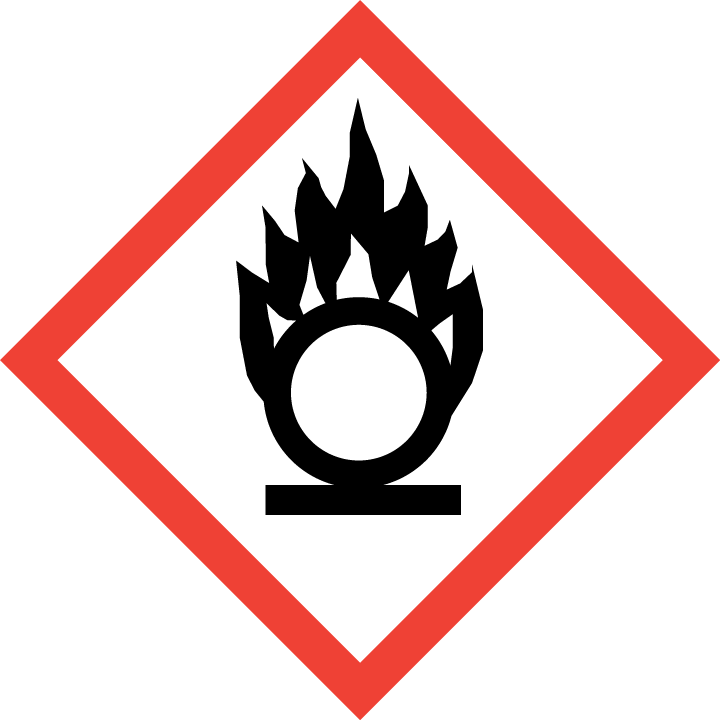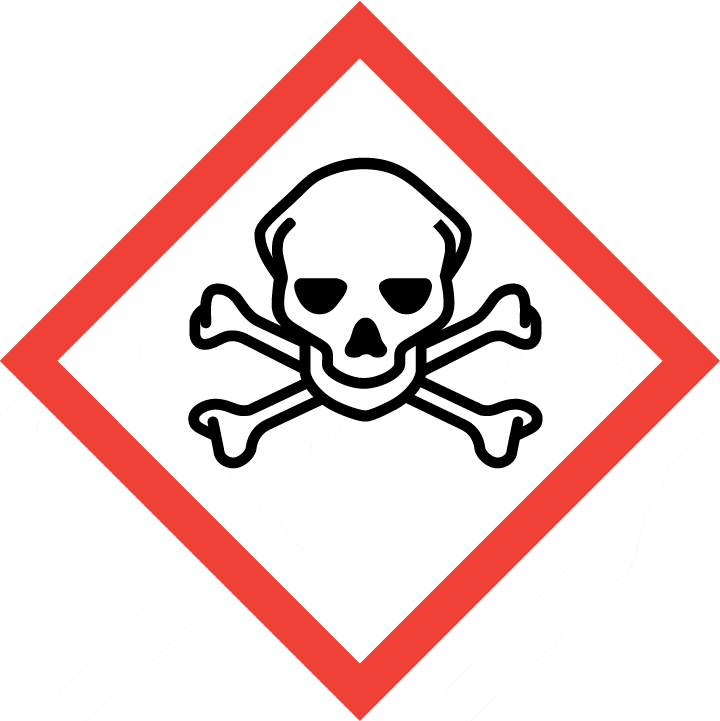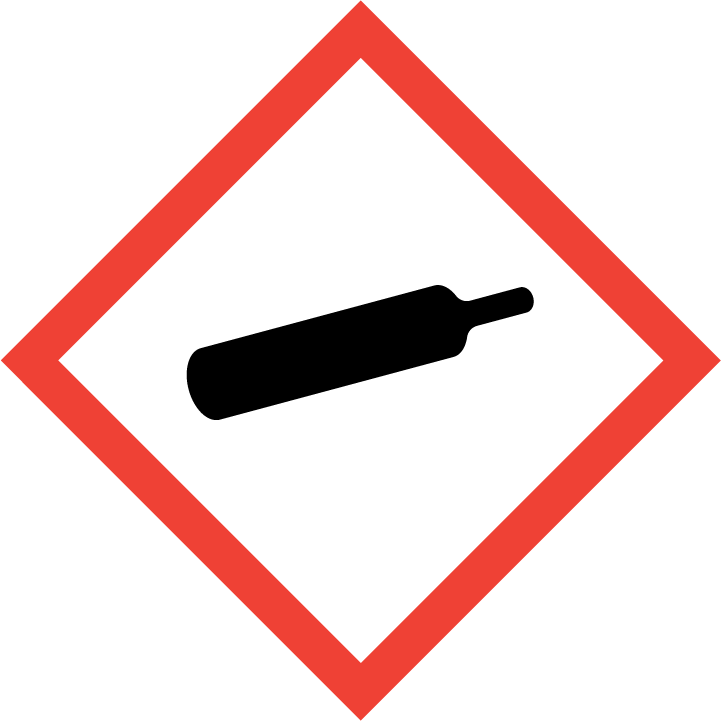1.Identification
1.1 GHS Product identifier
| Product name | difluorine |
|---|
1.2 Other means of identification
| Product number | - |
|---|---|
| Other names | Fluorine |
1.3 Recommended use of the chemical and restrictions on use
| Identified uses | For industry use only. Inorganic substances, Metals/Elements (the simplest forms of matter) |
|---|---|
| Uses advised against | no data available |
1.4 Supplier's details
| Company | MOLBASE (Shanghai) Biotechnology Co., Ltd. |
|---|---|
| Address | Floor 4 & 5, Building 12, No. 1001 North Qinzhou Road, Xuhui District, Shanghai, China |
| Telephone | +86(21)64956998 |
| Fax | +86(21)54365166 |
1.5 Emergency phone number
| Emergency phone number | +86-400-6021-666 |
|---|---|
| Service hours | Monday to Friday, 9am-5pm (Standard time zone: UTC/GMT +8 hours). |
2.Hazard identification
2.1 Classification of the substance or mixture
Gases under pressure: Compressed gas
Oxidizing gases, Category 1
Skin corrosion, Category 1A
Acute toxicity - Inhalation, Category 2
2.2 GHS label elements, including precautionary statements
| Pictogram(s) |     |
|---|---|
| Signal word | Danger |
| Hazard statement(s) | H270 May cause or intensify fire; oxidizer H314 Causes severe skin burns and eye damage H330 Fatal if inhaled |
| Precautionary statement(s) | |
| Prevention | P220 Keep away from clothing and other combustible materials. P244 Keep valves and fittings free from oil and grease. P260 Do not breathe dust/fume/gas/mist/vapours/spray. P264 Wash ... thoroughly after handling. P280 Wear protective gloves/protective clothing/eye protection/face protection. P271 Use only outdoors or in a well-ventilated area. P284 [In case of inadequate ventilation] wear respiratory protection. |
| Response | P370+P376 In case of fire: Stop leak if safe to do so. P301+P330+P331 IF SWALLOWED: Rinse mouth. Do NOT induce vomiting. P303+P361+P353 IF ON SKIN (or hair): Take off immediately all contaminated clothing. Rinse skin with water [or shower]. P363 Wash contaminated clothing before reuse. P304+P340 IF INHALED: Remove person to fresh air and keep comfortable for breathing. P310 Immediately call a POISON CENTER/doctor/… P321 Specific treatment (see ... on this label). P305+P351+P338 IF IN EYES: Rinse cautiously with water for several minutes. Remove contact lenses, if present and easy to do. Continue rinsing. P320 Specific treatment is urgent (see ... on this label). |
| Storage | P410+P403 Protect from sunlight. Store in a well-ventilated place. P403 Store in a well-ventilated place. P405 Store locked up. P403+P233 Store in a well-ventilated place. Keep container tightly closed. |
| Disposal | P501 Dispose of contents/container to ... |
2.3 Other hazards which do not result in classification
none
3.Composition/information on ingredients
3.1 Substances
| Chemical name | Common names and synonyms | CAS number | EC number | Concentration |
|---|---|---|---|---|
| difluorine | difluorine | 7782-41-4 | none | 100% |
4.First-aid measures
4.1 Description of necessary first-aid measures
General advice
Consult a physician. Show this safety data sheet to the doctor in attendance.
If inhaled
Fresh air, rest. Half-upright position. Artificial respiration may be needed. Refer for medical attention.
In case of skin contact
First rinse with plenty of water for at least 15 minutes, then remove contaminated clothes and rinse again. Refer for medical attention .
In case of eye contact
First rinse with plenty of water for several minutes (remove contact lenses if easily possible), then refer for medical attention.
If swallowed
Never give anything by mouth to an unconscious person. Rinse mouth with water. Consult a physician.
4.2 Most important symptoms/effects, acute and delayed
Poisonous; may be fatal if inhaled. Vapor extremely irritating. Contact may cause burns to skin and eyes. Chronic absorption may cause osteosclerosis and calcification of ligaments. (EPA, 1998)
4.3 Indication of immediate medical attention and special treatment needed, if necessary
Call for medical aid. ... Move to fresh air. If breathing has stopped, give artificial respiration. If breathing is difficult, give oxygen. ... Will cause frostbite. Flush affected areas with plenty of water. If in eyes, hold eyelids open, and flush with plenty of water. Do not rub affected areas.
5.Fire-fighting measures
5.1 Extinguishing media
Suitable extinguishing media
If material involved in fire: Do not extinguish fire unless flow can be stopped. Extinguish fire using agent suitable for type of surrounding fire. (Material itself does not burn or burns with difficulty.) Cool all affected containers with flooding quantities of water. Apply water from as far a distance as possible. Do not use water on material itself. Use water spray to knock-down vapors. /Fluorine, compressed/
5.2 Specific hazards arising from the chemical
May ignite other combustible materials (wood, paper, oil, etc.) Mixture with fuels may explode. Container may explode in heat of fire. Vapor explosion and poison hazard indoors, outdoors, or in sewers. Poisonous gas is produced in fire. Avoid contact with all oxidizable materials, including organic materials. Will react violently with water and most organic materials to produce heat and toxic fumes. Keep gas in tank, avoid exposure to all other materials. (EPA, 1998)
5.3 Special protective actions for fire-fighters
Wear self-contained breathing apparatus for firefighting if necessary.
6.Accidental release measures
6.1 Personal precautions, protective equipment and emergency procedures
Use personal protective equipment. Avoid dust formation. Avoid breathing vapours, mist or gas. Ensure adequate ventilation. Evacuate personnel to safe areas. Avoid breathing dust. For personal protection see section 8.
6.2 Environmental precautions
Evacuate danger area! Consult an expert! Personal protection: gas-tight chemical protection suit including self-contained breathing apparatus. Ventilation.
6.3 Methods and materials for containment and cleaning up
Keep water away from release. Approach release from upwind. Stop or control the leak, if this can be done without undue risk. Control runoff and isolate discharged material for proper disposal.
7.Handling and storage
7.1 Precautions for safe handling
Avoid contact with skin and eyes. Avoid formation of dust and aerosols. Avoid exposure - obtain special instructions before use.Provide appropriate exhaust ventilation at places where dust is formed. For precautions see section 2.2.
7.2 Conditions for safe storage, including any incompatibilities
Fireproof if in building. Cool.Store in cool, dry, well-ventilated location. Outside or detached storage is preferred. Isolate from all other storage.
8.Exposure controls/personal protection
8.1 Control parameters
Occupational Exposure limit values
Recommended Exposure Limit: 10 Hour Time-Weighted Average: 0.1 ppm (0.2 mg/cu m).
Biological limit values
no data available
8.2 Appropriate engineering controls
Handle in accordance with good industrial hygiene and safety practice. Wash hands before breaks and at the end of workday.
8.3 Individual protection measures, such as personal protective equipment (PPE)
Eye/face protection
Safety glasses with side-shields conforming to EN166. Use equipment for eye protection tested and approved under appropriate government standards such as NIOSH (US) or EN 166(EU).
Skin protection
Wear impervious clothing. The type of protective equipment must be selected according to the concentration and amount of the dangerous substance at the specific workplace. Handle with gloves. Gloves must be inspected prior to use. Use proper glove removal technique(without touching glove's outer surface) to avoid skin contact with this product. Dispose of contaminated gloves after use in accordance with applicable laws and good laboratory practices. Wash and dry hands. The selected protective gloves have to satisfy the specifications of EU Directive 89/686/EEC and the standard EN 374 derived from it.
Respiratory protection
Wear dust mask when handling large quantities.
Thermal hazards
no data available
9.Physical and chemical properties
| Physical state | pale yellow gas with a pungent odour |
|---|---|
| Colour | Pale yellow, diatomic gas or liquid |
| Odour | Sharp penetrating odor |
| Melting point/ freezing point | -220ºC |
| Boiling point or initial boiling point and boiling range | -188ºC |
| Flammability | Nonflammable Gas, but an extremely strong oxidizer.Not combustible but enhances combustion of other substances. Many reactions may cause fire or explosion. |
| Lower and upper explosion limit / flammability limit | no data available |
| Flash point | no data available |
| Auto-ignition temperature | Not flammable (USCG, 1999) |
| Decomposition temperature | no data available |
| pH | no data available |
| Kinematic viscosity | 0.257 mPa-s liquid at 85 deg K; 0.0218 mPa-s gas |
| Solubility | In water:reacts |
| Partition coefficient n-octanol/water (log value) | no data available |
| Vapour pressure | 760 mm Hg at -152.33°C (EPA, 1998) |
| Density and/or relative density | 1.695(15ºC) |
| Relative vapour density | 1.695 (EPA, 1998) (Relative to Air) |
| Particle characteristics | no data available |
10.Stability and reactivity
10.1 Reactivity
no data available
10.2 Chemical stability
Conditions contributing to instability: Elevated temp may cause cylinders to burst.
10.3 Possibility of hazardous reactions
Not flammableThe gas is heavier than air.Propellant; ignites upon contact with alcohols, amines, ammonia, beryllium alkyls, boranes, dicyanogen, hydrazines, hydrocarbons, hydrogen, nitroalkanes, powdered metals, silanes, or thiols [Bretherick, 1979 p.174]; Aluminum powder and iodine in close contact will ignite spontaneously, Fluorine with metals requires added heat for ignition, [NFPA 491M]. Antimony is spontaneously flammable in fluorine, chlorine, and bromine. With iodine, the reaction produces heat, which can cause flame or even an explosion if the quantities are great enough, [Mellor 9:379(1946-1947)]. The oxides of the alkalis and alkaline earths are vigorously attacked by fluorine gas with incandescence, [Mellor 2:13(1946-1947)]. Fluorine causes aromatic hydrocarbons and unsaturated alkanes to ignite spontaneously, [Mellor 2, Supp. 1:55(1956)]. Fluorine vigorously reacts with arsenic and arsenic trioxide at ordinary temperatures, [Mellor 9:34(1946-1947)]. Bromine mixed with fluorine at ordinary temperatures yields bromine trifluoride, with a luminous flame, [Mellor 2:12(1946-1947)]. Calcium silicide burns readily in fluorine, [Mellor 6:663(1946-1947)]. The carbonates of sodium, lithium, calcium, and lead in contact with fluorine are decomposed at ordinary temperatures with incandescence, [Mellor 2:13(1946-1947)]. A mixture of fluorine and carbon disulfide ignites at ordinary temperatures, [Mellor 2:13(1946-1947)]. The reaction between fluorine and carbon tetrachloride is violent and sometimes explosive, [Mellor 2, Supp. 1, 198(1956)]. The uncontrolled reaction between fluorine and chlorine dioxide is explosive, [Mellor 2, Supp. 1, 532(1956)]. Fluorine and silver cyanide react with explosive violence at ordinary temperatures, [Mellor 2, Supp. 1:63(1956)]. Fluorine and sodium acetate produce an explosive reaction involving the formation of diacetyl peroxide, [Mellor 2, Supp. 1:56(1956)]. Selenium, silicon, or sulfur ignites in fluorine gas at ordinary temperatures, [Mellor 2:11-13(1946-1947)]. Each bubble of sulfur dioxide gas led into a container of fluorine produces an explosion, [Mellor 2:1(1946-1947)]. Fluorine and thallous chloride react violently, melting the product, [Mellor, Supp. 1:63(1956)].
10.4 Conditions to avoid
no data available
10.5 Incompatible materials
Strong oxidizer. Reacts with every known element except, helium, neon, argon. Reacts with all materials except for some Teflons and some metals at low temperatures. Water reactive. Reacts with water to form hydrogen fluoride and oxygen.
10.6 Hazardous decomposition products
Decomposes in water, giving hydrofluoric acid, HF, oxygen fluoride, OF2, hydrogen peroxide, oxygen and ozone.
11.Toxicological information
Acute toxicity
- Oral: no data available
- Inhalation: LC50 Rat inhalation 185 ppm/1 hr
- Dermal: no data available
Skin corrosion/irritation
no data available
Serious eye damage/irritation
no data available
Respiratory or skin sensitization
no data available
Germ cell mutagenicity
no data available
Carcinogenicity
no data available
Reproductive toxicity
no data available
STOT-single exposure
no data available
STOT-repeated exposure
no data available
Aspiration hazard
no data available
12.Ecological information
12.1 Toxicity
- Toxicity to fish: no data available
- Toxicity to daphnia and other aquatic invertebrates: no data available
- Toxicity to algae: no data available
- Toxicity to microorganisms: no data available
12.2 Persistence and degradability
no data available
12.3 Bioaccumulative potential
Fluorine decomposes in water to form hydrofluoric acid (HF), hydrogen peroxide (H2O2) and oxygen fluoride (OF2)(1). Therefore, bioconcentration in aquatic organisms is not expected to be an important fate process(SRC).
12.4 Mobility in soil
Elemental fluorine was found to be very mobile in both sandy and sandy loam soils(1). Fluorine decomposes in water to form hydrofluoric acid (HF), hydrogen peroxide (H2O2) and oxygen fluoride (OF2)(2); therefore, fluorine is expected to decompose in moist soils as it reacts with water(SRC).
12.5 Other adverse effects
no data available
13.Disposal considerations
13.1 Disposal methods
Product
The material can be disposed of by removal to a licensed chemical destruction plant or by controlled incineration with flue gas scrubbing. Do not contaminate water, foodstuffs, feed or seed by storage or disposal. Do not discharge to sewer systems.
Contaminated packaging
Containers can be triply rinsed (or equivalent) and offered for recycling or reconditioning. Alternatively, the packaging can be punctured to make it unusable for other purposes and then be disposed of in a sanitary landfill. Controlled incineration with flue gas scrubbing is possible for combustible packaging materials.
14.Transport information
14.1 UN Number
| ADR/RID: UN1045 | IMDG: UN1045 | IATA: UN1045 |
14.2 UN Proper Shipping Name
| ADR/RID: FLUORINE, COMPRESSED |
| IMDG: FLUORINE, COMPRESSED |
| IATA: FLUORINE, COMPRESSED |
14.3 Transport hazard class(es)
| ADR/RID: 2.3 | IMDG: 2.3 | IATA: 2.3 |
14.4 Packing group, if applicable
| ADR/RID: unknown | IMDG: unknown | IATA: unknown |
14.5 Environmental hazards
| ADR/RID: no | IMDG: no | IATA: no |
14.6 Special precautions for user
no data available
14.7 Transport in bulk according to Annex II of MARPOL 73/78 and the IBC Code
no data available
15.Regulatory information
15.1 Safety, health and environmental regulations specific for the product in question
| Chemical name | Common names and synonyms | CAS number | EC number |
|---|---|---|---|
| difluorine | difluorine | 7782-41-4 | none |
| European Inventory of Existing Commercial Chemical Substances (EINECS) | Listed. | ||
| EC Inventory | Listed. | ||
| United States Toxic Substances Control Act (TSCA) Inventory | Listed. | ||
| China Catalog of Hazardous chemicals 2015 | Listed. | ||
| New Zealand Inventory of Chemicals (NZIoC) | Listed. | ||
| Philippines Inventory of Chemicals and Chemical Substances (PICCS) | Listed. | ||
| Vietnam National Chemical Inventory | Listed. | ||
| Chinese Chemical Inventory of Existing Chemical Substances (China IECSC) | Listed. | ||
16.Other information
Information on revision
| Creation Date | Aug 12, 2017 |
|---|---|
| Revision Date | Aug 12, 2017 |
Abbreviations and acronyms
- CAS: Chemical Abstracts Service
- ADR: European Agreement concerning the International Carriage of Dangerous Goods by Road
- RID: Regulation concerning the International Carriage of Dangerous Goods by Rail
- IMDG: International Maritime Dangerous Goods
- IATA: International Air Transportation Association
- TWA: Time Weighted Average
- STEL: Short term exposure limit
- LC50: Lethal Concentration 50%
- LD50: Lethal Dose 50%
- EC50: Effective Concentration 50%
References
- IPCS - The International Chemical Safety Cards (ICSC), website: http://www.ilo.org/dyn/icsc/showcard.home
- HSDB - Hazardous Substances Data Bank, website: https://toxnet.nlm.nih.gov/newtoxnet/hsdb.htm
- IARC - International Agency for Research on Cancer, website: http://www.iarc.fr/
- eChemPortal - The Global Portal to Information on Chemical Substances by OECD, website: http://www.echemportal.org/echemportal/index?pageID=0&request_locale=en
- CAMEO Chemicals, website: http://cameochemicals.noaa.gov/search/simple
- ChemIDplus, website: http://chem.sis.nlm.nih.gov/chemidplus/chemidlite.jsp
- ERG - Emergency Response Guidebook by U.S. Department of Transportation, website: http://www.phmsa.dot.gov/hazmat/library/erg
- Germany GESTIS-database on hazard substance, website: http://www.dguv.de/ifa/gestis/gestis-stoffdatenbank/index-2.jsp
- ECHA - European Chemicals Agency, website: https://echa.europa.eu/


 沪ICP备2021018848号-5
沪ICP备2021018848号-5

